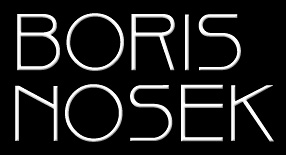|
Development of his work can be devided into four stages. Stylization, which appears more or less in all four stages, is typical by cutting out unimportant and underlining and exaggerating important things. On first stage there are mainly studies of movement, anatomy of muscles and realistic nature of the animal. Main forming element is the line. Characteristic feature for the second period is fragment, representing the most typical detail of animal so as everyone knows which animal is author dealing with. The third period is characteristic by tangent and structural variety of surfaces of different species. In last, fourth period, he comes to symbolical simplicity of animal, symbolising magic metaphor of human destiny. During this period comes to linking between Antiquity and the Modern Age, Ancient Egypt, Art Nouveau and Gothic art, European and Indian cultures. Boris Nosek tries to express animal as a moving monument, with its specific structure of its body, characteristic signs and differences. He purposely keeps to conception, where animal is dominative and there is no sign of background or environment, where it lives.
Present authors works comprise three different series: decorative series "HEARTDECO", drawing "MIMIKRY" and mysterious "ANTELOPES OF NIGHT". Inspiration for all works was again world of animals, but each time from a different point of view.
First series Heartdeco is basically reminiscence of world-famous style of the twentieth - Artdeco. The author is recording in symbolic conception magic strength of wild cats in contrast with elegance of birds. Series of pictures completing drawing series of wild cats, antelopes and monkeys having similar symbolic character and handwriting.
In series are dominant structural elements with relief processing of main motifs, as well as whole decorative effect.
Applying his combined techniques, Boris Nosek uses a high relief of latex mass together with other materials, combining with smooth surfaces.
Main authors theme still remains cheetah, being gentle, strong, fast, but also elate. Series of cheetah symbolises also human relationships, problems characteristic for our human world, symbolises love of man and woman, male and female duality principle, but also life earthly and heavenly, world of fantasy and reality. Equally, the symbolic images or characteristic motifs are cryptograms of validity, whether you think of the flower, cross, heart, drop ... Boris Nosek uses three basic types of technique of drawing on porcelain - underglazed paintings, overglazed paintings and paintings with absorbing colours. He belongs to a small group of artists in CR using these techniques coming from old China and their plans realise on industrial shapes and also on original design. There is connection becoming between "art" and industrial production of art. Underglazed paintings are salts of metals /chlorides and nitrates/, absorbing colours, for instance cobalt and matt black. These are on many objects - are overglazed colours. In many techniques comes to combinations and each porcelain object has to be three or four times in kiln. The most common is painting with salts under glaze, which have aquarelle character. Dominative brawn line is drawn by gold under glaze, which is in contrast with mild pastel colours of salts. There are series on porcelain made with these techniques - series of birds and fish and whole range of vases. Typical example of absorbing colours is drawing with cobalt burn on 1380° having again smooth character without sharp contour. We can reach this softness only by burning on high degrees, when the colour melts and fades into glaze. Sample of this technique is China vase with lid "Swans bath". Colours on surfaces having always sharp contrast with basis, usually black colour in combination with gold drawing, author in many cases scrapes in order to show his experience with graphics and whole appearance of work reminds us of woodcutting or linoleumcutting - "Zebras in night".
At the end a quotation of the author: |
